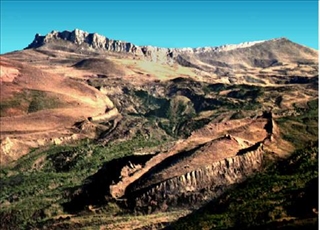
The Caucasus Mountains were, and still are, mineral rich. This was known to the ancient Babylonians,Greeks, and Egyptians as they traded in this area. Ancient sources say that the area was much richer in timber and wildlife variety than now, and volcanoes were active.
(4)Apart from the mineral resources, Anatolia and Trans-Caucasia are rich in plant life. Anatolia is situated at the meeting of three principal zones of distribution of plants: these are the so-called Euro-Siberian zone (Europe, Russia, and Siberia), the Irano-Turanian zone (the steppes of central Asia, Iran and central Anatolia) and the Mediterranean zone. The Black Sea littoral belongs to the first zone, the Anatolia plateau to the second and the southe coast of Turkey to the thrid. Recent work has shown a large percentage of plants which are endemic, that is, confined to Turkey: this is particularly true of the Taurus ranges, where the Irano-Turanian and Mediterranean botanical zones meet.
(5) So it is evident, that God had tooken care of Noah, his wife and family by placing the Ark in a spot that was and still is rich in resources.
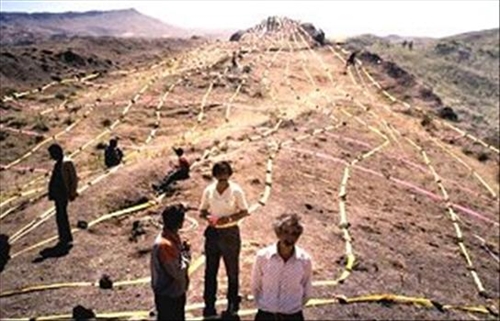
"You must remember that today it is taught that man began as an apelike critter who stumbled across fire after a lightning strike. He then progressed to man-like, but was extremely primitive, hunting with crude stone implements, eating the flesh off the bones because he had no pottery or utensils. And then one day he suddenly began to plant crops and raise herds. I suggest you keep this in mind when you read archaeological reports; and totally disregard the dates they assign to different sites. We will be wise to concentrate ONLY on the evidence – and what it alone reveals."
(7) Later on in this article, we will cite a few examples of the levels of sophisication and knowledge, the 1st and 2nd generations of Noah possessed up to the Tower of Babel and beyond.
What we know today as cavemen, we're in reality, highly sophisticated and technologically advanced human beings who's works cannot be duplicated today by our best equipment and engineers. Since the Ark landed in the "Mountains of Ararat"(eastern Turkey), and the Ice Age began at that time,one would expect caveman fossils to be prevalent in areas at the edge of the icepack, and in areas within range of the mountains of Ararat, as to be with only hundreds of years of human migration away from eastern Turkey. That is exactly what the record reflects. Most all the caveman fossils are within a few thousand miles of eastern Turkey, and near the edge of the (now greatly diminished) Ice Age icepack.
(8) It is significant that few caveman fossils were discovered where the great initial civilizations of the post-Flood world once thrived.
The areas of ancient Babylon, Egypt and the Harappa Civilization (northwest India where the towns like Mohenjo-Daro had advanced plumbing) are caveman free. One might think caveman ancestors would have evolved into the technologically advanced builders of these great and earliest civilizations; yet, the caveman fossils are not found at these sites. After the eight people with the animals came off the Ark and began to repopulate the earth, the clans that retained much knowledge from the pre-Flood world and were more organized and aggressive claimed the best land and began building the highly advanced, earliest cultures. The less effective clans were forced to move out. Progressively, the less technologically and organizationally sophisticated clans were forced farther and farther away, out across Europe and Asia, into desolate and foul Ice Age environments, and to the south and east, as well. They often lived in caves (cheap housing) and made due with simple tools and clothing. As the Ice Age was ending. The cavemen physical abnormalities also diminished. The Bronze Age actually occurred while the Stone Age and played out along the Ice Age. The offspring of the Ark survivors, who built the earliest civilizations in the Middle East, had retained metallurgical and mathematical skills. They quickly claimed the mineral deposits in the area and began metal production.
(7)
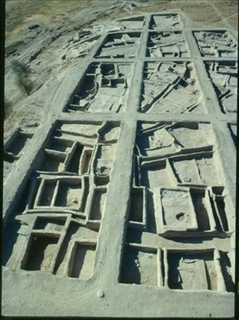
The obvious progress in man's technological developments over the centuries may seem, superficially, to represent a form of evolutionary progress, but it really is an evidence against evolution instead. That is, such progress is attributable to a capacity in man which sets him completely apart from the animals; namely, the ability to acquire knowledge and skills in one generation and then pass those on to the next generation. Thus, the advances in civilization over the period of human history do not represent evolution at all, but rather man's unique ability to transmit new knowledge. There are, for example, many people who have a "stone age" culture, in today's age of science and technology. If such people are living today, it is obvious that there myst have been similiar people living in the world during every age. Nevertheless, they are all typical men' with the proper incentives and opportunities, these people have the same range of potential skills as those who were born in more civilized societies. ( Note- example being the Alamblaks tribe in Northwestern Papua-New Guinea. These people live entirely by hunting and gathering, with wooden implements. Nevertheless, the live in organized villages, have an exceedingly complex language, an intricate social structure, and are very intelligent and friendly people ) Whereever a new settlement was located, it would be evidenced first by a brief "stone age" interval. The stone-age would be followed rather quickly by evidences of urbanization and other marks of civilization. A state of high technological ability would be evidenced very early in the history of each region, often followed by invasion from outside or by internal decline. Evidences of civilization would appear more or less contemporaneously all over the world, with a slight priority in time noted at closer distances to the center of dispersion.
(1)
After the Flood, Noah and his family became and was total world population. One can only imagine what emotions and thoughts were going thru their head. The only noises to be heard was the animals as they off load and scatter about the Araxes Valley and the Armenian Highlands to scatter upon the face of the earth.Those eight people must have felt a deep sense of being alone, not to mention life was alot harder than before the Flood; now the entire face of the earth was harsh and rugged. Plants had to be cultivated, animals had to be bred and cared for whereins before the flood, God had created everything and provisions were on the tap meaning very easily accessible and there was no need to consume meat. God gave mankind, the fruits, herbs, nuts and seeds of the earth. It wasn't until after the flood where now eating meat was required for survival ( plants not being in bloom in winter) and speaking of weather, the climate was alot different than what it is today.
Brief on the Pre-Flood Weather
There is definite evidence that our planet once presented a warm
subtropical climate from pole to pole.
- Corals, which grow only in warm waters (of at least 20 degrees
Centigrade) once grew near the poles. Canada, Alaska,
Newfoundland, Greenland and Spitzbergen contain fossil coral.
- Coal seams are also found near the poles. The vast coal beds are
simply fossilised remains of trees and plants.
- The remains of animals now confined to warm regions are found all
over the earth.
- Antarctica: In 1976, an Italian expedition discovered away below
the ice - a petrified forest!
- Antarctica: The Admiral Byrd expedition found and photographed a
mountain composed totally of coal, indicating former lush growth
here. They also found ancient palm trees under the ice.
- Antarctica: In 1968, in the mountains of central Antarctica, an
American expedition came upon the jaw bone of a crocodile-like
amphibian (called a labyrinthodont), as well as skeletons of other
animals - creatures that could have survived only in a warm to hot
climate. Similar finds were made again in 1986.
- Northern polar regions: Abundant remains of tropical animals have
been uncovered in icy Greenland, Alaska and Siberia.
- In these same northern polar regions are numerous fossil trees:
beech, myrtle, laurel, breadfruit, cinnamen, oak, walnut, banana,
grape vines, and so on. And from a line north of Labrador across to
Alaska: giant sequoias.
- Spitzbergen and Greenland now shiver in darkness for half of the
year and lie almost continuously under snow and ice. Yet a rich,
temperate flora once covered these icy wastes in the Arctic Ocean.
Fossil remains of magnolias, fig trees, palms, arborescent ferns
(which are typically tropical) and animals from warm climates have
been discovered… also pines, firs, spruces, cypresses, elms, hazels
and water lilies.
- South polar region: Redwood forests are found buried under massive
ice deposits. These towering giants (now typically found in the
north-west of the U.S.A.) once flourished in many diverse parts of
the world, as evidenced by many coal and fossil finds.
- Back to the Arctic Circle: Here are two very interesting island
groups - the New Siberian Islands and the Spitzbergen Islands.
Remarkable things have been reported by explorers who have been
there. Immense frozen gravel mounts were discovered to have
entombed within them entire fruit trees with the fruit still on them.
(D.G. Whitley, “ The Ivory Islands in the Arctic Ocean”, Journal of the Philosophical
Society of Great Britain, XII, 1910, p.49. Cited in Earth in Upheaval, by Immanuel
Velikovsky, Dell ed., 1955, p.19)
- In the New Siberian Islands, whole palm trees have been found, with
their leaves and fruit.
Tropical animals cannot live in icy water. Neither can sub-tropical plants ripen seeds and sow themselves in arctic conditions. Geologist George McCready Price sums up the findings: "If we listen to the unequivocal testimony of tropical plants and animals found away to the north and even within the arctic regions, we must declare that geology knows only one climate until this sudden change came; and this astonishing climate seems to have been practically uniform over the entire globe."
(10)
What we now call climate was unknown in these geological times. There seems to have been then only one climate over the whole globe.”
(11) Pale-botanist R.W. Chaney has shown from fossil plants that the climate was slightly warmer near the equator and cooler near the poles.
(12) There were these slight differences of latitude climate, but not the present zonal extremes. Overall, the climate of Planet Earth was mild and springlike, perfect from pole to pole.
There is good reason to believe that this world of perfect climate existed within the memory of the human race. The traditions of ancient humanity preserve the recollection of it. The ancient Chinese say that before the great Catastrophe, “ four seasons succeeded each other regularly and without confusion. There were no impetuous winds, nor excessive rains. The sun and moon, without ever being clouded, furnished a light purer and brighter than now.”
(13) Numerous ancient traditions contain details of the world “ before the Flood” , details which seem to stem from a common origin: the original perfect state; a glorious land; long age spans; but growing disobedience to spiritual laws and eventual destruction.
(9)
It would of been extremely important for families to remain together for mutual protection and that of their flocks and herds. Considering that the gestation period for animals is faster than that of which a human can reproduce, i suspect it wouldn't of tooken long for the animal population to explode and now were building houses custom fitted for keeping out predatory animals.
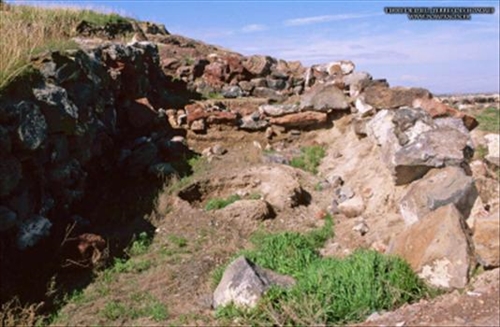
"Ancient sites in Turkey have revealed large stone walls which, in the absence of any evidence of invaders, could only have been for protection from the wild animals. Also many ancient homes have been found which had no doorway but were entered through the roof by ladders which also could have been for this purpose" The
Asikli Hoyuk site is a good example. Asikli, a 15 metre (15-foot) high mound, stands on the western side of present-day Turkey’ s Konya plain, to the south-east of the town of Aksaray. Here, entry and exit to the dwellings was via holes in the roof. In various ancient sites, some houses were built side by side almost as one single unit, with doors entering a central courtyard with a single exit to the
outside. Also many buried their dead below a stone slab under the floor of their houses; this could very well have been to protect them from being dug up and eaten by animals. Man has long recognised the necessity of preventing the “ man-eating tigers” of which we hear occasionally. At Asikli, the dead were buried beneath the rooms’ floors.
Asikli Hoyuk – The Oldest Settlement in Anatolia(7)
Also at the site of Catal Huyuk, the thick walled houses were made without doors, but instead add to entered and exited through the rooftops. Could this have been another protection measure against the wild beasts? as in the case the cliff dwellers of Edom and Petra? At an ancient site west of Ninevah, a barrier wall is 148 feet thick in some spots. What kind of animals were they protecting themselves against? In a future article, we will examine the beasts of the book of Job and the definition for dragon. Also, importantly we will go outside of the bible and christian sources to the historic record and the encounters of some people, whom we all know well to history, like Alexander the Great, Marco Polo, Beowulf, The Loch Ness monster, and more.
Just about every known country and civilization in the world past and present all have a flood legends. While yes the names are different, the numbers may vary and details may be omitted and added, but the theme in every account is the same. If it were just one or two or three, it could be wrote off as fairy tale or playwright, but when you start throwing around names like the Bible, the Mayans, Aztecs, Egyptians, Romans, Babylonians, Greeks, Africans, Native American Indians, Welch, The Chinese, India, etc..... all claiming in their own history and legends that this world was destroyed by water at some point in time past. It lends credibility to the event really happening.
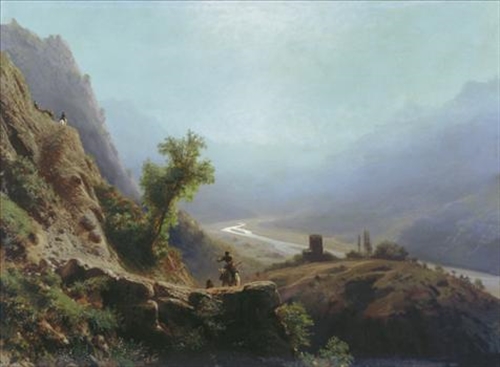 Painting : On the Caucasus Mountains by Lev Legorio (1879)
Painting : On the Caucasus Mountains by Lev Legorio (1879)On the North side of Kazan is a ridge of hills and on the other side is the Araxes River – and across the river is the site of Medzamor. Which is not far from Armarvir-Blur, a metallurgical workshop with its origins dating back well into the 3rd millennium BC. One of the oldest metallurgical factory site in the world. It is located a few miles from where Noah's home was. Analyses of copper found 14 different alloys, including tin, lead, antimony and zinc. The centre was sophisticated. Clay pipes were found inserted into the furnaces, as well as phosphorus bricks, used in the smelting of cassiterite to obtain tin. Here vases and objects made of all the common metals have been found. Fourteen varieties of bronze were smelted for different purposes. Medzamor also produced metallic paints ceramics and glass. And the craftsmen wore mouth-filters and gloves, as do modern craftsmen. The factory is believed to have had more than 200 furnaces. Ore was brought in and the finished products distributed to all other areas. Several pairs of tweezers have been unearthed here. The steel used in the tweezers was of an exceptionally high grade. The tweezers were like eyebrow tweezers, that enable chemists and watchmakers to handle micro-objects which they cannot manipulate by hand. The manipulation of such micro-objects implies the use of microscopic lenses. French journalist Jean Vidal reported in Science et Vie of July, 1969: “ Medzamor was founded by the wise men of earlier civilizations. They possessed knowledge they had acquired during a remote age unknown to us that deserves to be called scientific and industrial."
(7)
"The ancients utilized almost all the tools of modern carpentry: axes, adzes, hammers, mallets, wedges,chisels, drills, lathes, t-squares, plumb bobs, comasses, planes, and rasps. Almost all modern carpentry techniques were also performed: mortising, tenoning, treenailing, beveling, gluing, and intricate join-ing and inlaying.Post-Flood mariners navigated the globe, as evidenced by the intricate maps that reveal pre-Ice Ageshorelines and geomorphic features that only recently have been verified by remote sensing through the icepacks of the polar regions The accuracy of the longitudes and latitudes on these maps necessitates high technological savvy. The recent revelation of such a capability, through the utilization of an instrument for astronomical measurements that consists of a wheel on a cross that is oriented by a plumb bob, shows that the ancients had the know-how to navigate and survey with modern precision. The pyramid builders of earliest Egypt and the ziggurat builders of Assyria, Babylon, the Mayans, and of the Incas, display incredibly advanced engineering acumen, and probably utilized this “Celtic Cross” for their engineering surveys."
(6)“ The perforation of large objects like maceheads presented no difficulty; but it was another matter with the drilling of some of the stone beads, including those of obsidian, which have perforations too fine for a modern steel needle. It is quite uncertain how this was achieved.… ”
(3)The bottom line is this: In the regions extending out from south central Turkey (our site for Babel) the archaeological evidence reveals very early villages and towns whose earliest level (on virgin soil) presents concrete evidences of people who possessed very advanced technical knowledge. “ … recent, revolutionary finds have left no doubt that it is in the Southern regions of Central Anatolia that Neolithic civilization achieved its greatest progress.”
(2)